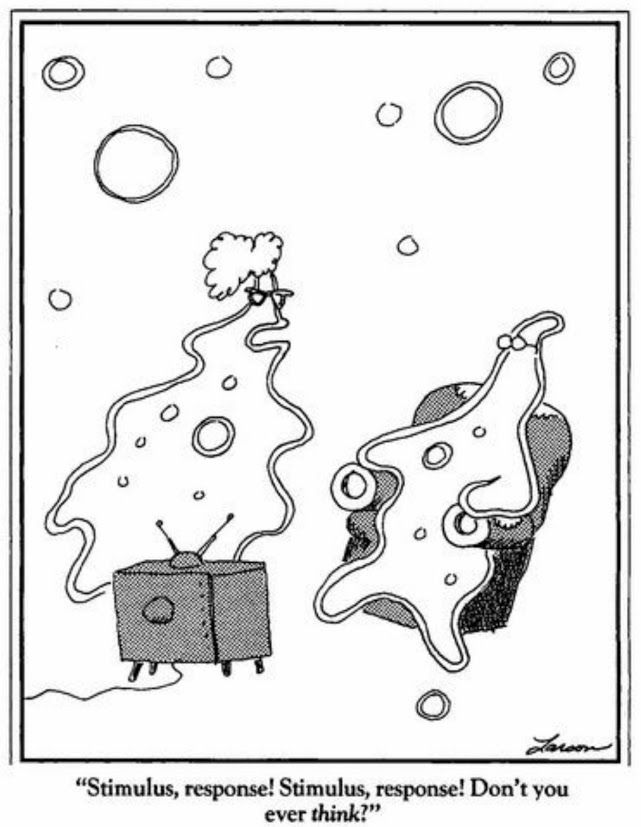Take home message of the 2010 Amebiasis Montreal Meeting: beware of who you kiss…

The Entamoeba community is a small and collegial one. Everyone knows everyone and everyone else wants to collaborate, and learn and do more to tackle down this neglected among neglected diseases. For many, the thought of an amoeba brings to memory Garry Larson’s The Far Side amorphous characters watching TV and dealing with domestic issues…but what a few know is that the WHO considers amebiasis one of the major health problems in developing countries surpassed only by malaria and schistosomiasis for death caused by a parasitic infection.

TIGR/JCVI has had a long-standing relationship with Entamoeba histolytica and other related species. Started by Brendan Loftus back in the day, followed by Neil Hall and continuing by yours truly, with the Entamoeba GSCID project, we have provided this eager community with what they are in great need of: genome sequences. And they are appreciative of that, for sure.
The meeting was small and intense, and started with a one day workshop on clinical aspects of the disease, not only the enteric disease, but the oral disease. It was good to mingle with dentists and see their point of view and the devastating reality of clinical cases of periodontal disease…and periodontal disease affects, at one point of another, the majority of the adults. And Entamoeba gingivalis is always there…but not always diagnosed. Why? We assumed bacteria, bacteria, and bacteria. Treat the bacteria with antibiotics…but ignore the amoebas. Patients do everything right when it comes to oral hygiene, but the disease persists, the bone continues to be destroyed, and teeth are lost…secondary consequences such as fatigue, diabetes, heart disease, renal dysfunction, low birth weight, and a myriad of other diagnoses are known to be related to oral health and periodontal disease, but rarely in the context of this amebiasis infections. Interesting cases of entire families being affected by this parasite were presented (it is highly contagious). Dr. Bonner, the organizer of the conference is a big advocate of microscopes in the dentist practices as the primary diagnostic method for periodontal disease and identification of amebiasis, and he is surely determined to speak to the world about that. And he also wants the genome done.
During the core of the Meeting, Neil Hall and myself were the only ones on the genomics side of things: we presented on SNP analysis done so far on the strains we have sequenced, in their case using SOLiD, on our case just 454 (for now). Both talks were very well received and the community is eager to see more. Both pieces of work will be used in a global SNP analysis, particularly focusing on a family of proteins known to be involved in virulence, the Gal/GalNac lectins. These proteins are one of the main targets for vaccine development, led by Dr. Bill Petri, who is in the process to start full speed with that endeavor. Also on this topic, Dr. Jonathan Ravdin (Dean and Executive Vice President of the Medical College of Wisconsin) presented the results on an intranasal Gal-lectin subunit vaccine on experimental Entamoeba histolytica in baboons, showing its protective effect against enteric colitis, and the promising future of this vaccine target for humans.
For amebiasis “a la mode”, the usual suspect topics of the conference involved Entamoeba histolyica signaling pathways, classic protein characterization of large families, proteases and invasion, and large genotyping studies of outbreaks, as well as mechanism of pathogenesis. One interesting talk was on the generation of cyst like forms in vitro for Entamoeba histolytica, a true breakthrough, since there is no model or encystations so far, and the possibility to obtain this structures in vitro will certainly open up a whole new world of studies that before were confined to Entamoeba invadens, a very distant parasite of lizards that does encyst in vitro.
A modest interest into drug discovery was present. There are so far two kind of drug therapies for amebiasis, luminal amoebicides (paromomycin, diloxanide furoate and iodoquinol) for intestinal disease, but ineffective against organisms in tissue and metronidazole and other derivatives, for invasive disease. However, resistance to these drugs is easily achievable at clinically acceptable drug levels. James McKerrow (UCSF) group presented a high throughput screening of small molecules using an FDA-approved library of drugs and known bioactive compounds, and they identified six compounds with similar or better activity than metronidazole, in vitro. Other group from Mexico is focusing on probiotics and natural compounds such as Astrophitus capricorne (cactus), Jatrhropa dioica and Eucalyptus camaldulensis.

To finalize, because the list of interesting things can be just too much, a wonderful piece of work that will hopefully provide an extensive framework for further studies of host susceptibility to E. histolytica comes from Bill Petri’s lab. They have performed a small hairpin RNA (shRNA) screen to identify human factors crucial for E. histolytica cytotoxicity. Using a mammalian shRNA knockdown library they did nine rounds of selection using 1:5 parasite:host and 1:50 parasite:host ratios and resistant clones after 6 rounds of selection, were sequenced using Solexa. This way, they identified a number of host gene families including kinases, surface receptors and ion channels that may be important for susceptibility to the parasite, and of course, they are working on that…
But the take home message that I have imprinted in my brain is…do not kiss your dog. After three years of age, ALL DOGS have periodontal disease. And inevitably they have Entamoeba gingivalis and possibly other species as well…and they are one of the sources of infection to humans. Dog kisses owner, owner kisses lover, wife, husband, and kids…and the amoeba conquest of the world continues…
For your delight, two movies on the topic: Mark Bonner, the meeting organizer (in French) and a film of a patient with periodontal disease biofilm. Enjoy!